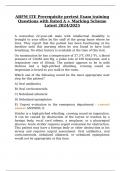ABFM ITE Prerequisite pretest Exam training
Questions with Rated A + Marking Scheme
Latest 2024/2025
A nonverbal 22-year-old male with intellectual disability is
brought to your office by the staff of the group home where he
lives. They report that the patient has been functioning at his
baseline until this morning when he was found to have loud
breathing. No other history is available at the time of this visit.
On examination he has a temperature of 37.3°C (99.1°F), a blood
pressure of 124/82 mm Hg, a pulse rate of 100 beats/min, and a
respiratory rate of 16/min. The patient appears to be in mild
distress and a high-pitched whistling, crowing sound on
inspiration is heard as you walk in the room.
Which one of the following would be the most appropriate next
step for this patient?
A) Oral antibiotics
B) Oral corticosteroids
C) Nebulized albuterol
D) Nebulized epinephrine
E) Urgent evaluation in the emergency department - correct
answer ANSWER: E
Stridor is a high-pitched whistling, crowing sound on inspiration.
It can be caused by obstruction of the larynx or trachea by a
foreign body, vocal cord edema, a neoplasm, or a pharyngeal
abscess. Acute stridor requires urgent evaluation for obstruction.
This patient may have a foreign body or other obstruction in his
airway and requires urgent assessment. Oral antibiotics, oral
corticosteroids, nebulized albuterol, or nebulized epinephrine
would not be appropriate at this time.
,A 16-year-old female presents with chronic acne on her nose,
forehead, and chin consisting of a few comedones and a few
mildly inflamed papules and pustules. She says it is minimally
improved after 12 weeks of daily adapalene 0.1% gel. There are
no scars or cysts. The patient would like to try to achieve better
control.
Which one of the following would you recommend at this time?
A) Continue adapalene 0.1% gel for 12 more weeks
B) Add clindamycin (Cleocin T) 1% gel for up to 12 weeks
C) Add clindamycin 1% gel for maintenance
D) Stop adapalene 0.1% gel and start clindamycin 1% gel for
maintenance
E) Stop adapalene 0.1% gel and start erythromycin 2% gel for
maintenance - correct answer ANSWER: B
Family physicians are often asked to manage mild to moderate
acne vulgaris. Topical retinoids such as adapalene and benzoyl
peroxide are first-line therapy and a trial of therapy is typically 8-
12 weeks. Topical antibiotics may be added to topical retinoids or
benzoyl peroxide to achieve better symptom control. To decrease
emerging antibiotic resistance, studies support limiting antibiotic
use to 12 weeks except in severe cases, not using antibiotics as
monotherapy, and using clindamycin rather than erythromycin.
Adding clindamycin gel rather than erythromycin gel for up to 12
weeks is recommended for this patient at this time.
A 32-year-old female who is one of your longtime patients calls
you because of a 24-hour history of painful urination with urinary
frequency and urgency. She is otherwise healthy and does not
have any fever, chills, back pain, or vaginal discharge. She uses
an oral contraceptive pill and states that her last menstrual
period was normal and occurred last week.
,Which one of the following would be most appropriate at this
time?
A) Empiric antibiotic treatment
B) A urinalysis
C) A urine culture
D) Plain abdominal radiographs
E) Pelvic ultrasonography - correct answer ANSWER: A
This patient has symptoms of acute simple cystitis and does not
have any symptoms that would suggest a complicated urinary
tract infection or vaginal infection. In these cases treatment with
oral antibiotic therapy may be prescribed without further
evaluation (SOR B). Simple cystitis is a clinical diagnosis and a
urinalysis and urine culture are not necessary. The patient does
not have any symptoms that warrant evaluation with abdominal
radiographs or pelvic ultrasonography.
A 70-year-old female develops thrombocytopenia during a
prolonged hospitalization for endocarditis. Her current
medications include scheduled unfractionated heparin injections
for venous thromboembolism prophylaxis. You suspect heparin-
induced thrombocytopenia (HIT).
Assuming that her thrombocytopenia is caused by HIT, which one
of the following is the most likely complication?
A) Anaphylaxis
B) Disseminated intravascular coagulation
C) Hemorrhage
D) Sepsis
E) Thrombosis - correct answer ANSWER: E
Heparin-induced thrombocytopenia (HIT) is an immune-mediated
process that occurs in approximately 1 in 5000 hospitalized
, patients. Patients are at highest risk 7-10 days after exposure to
unfractionated heparin, and the risk is particularly high after
cardiac surgery, which is associated with an estimated rate of
1%-3%. In contrast to other causes of thrombocytopenia, HIT
places patients at a paradoxically increased risk of thrombotic
complications, with clotting events occurring in roughly 50% of
confirmed cases of HIT. Lower-extremity deep vein thrombosis
and pulmonary embolism are the most common thrombotic
complications, followed by arterial thromboses, stroke, and
myocardial infarction, in descending order of frequency.
Thromboses often occur concurrently with the development of
thrombocytopenia or shortly thereafter. The risk of HIT can be
determined with the 4T scoring system, which evaluates the
acuity of thrombocytopenia, timing of onset, presence of
thrombosis, and alternative causes of thrombocytopenia. Patients
with an intermediate or high pretest probability should be
managed with prompt discontinuation of heparin and initiation of
full-dose anticoagulation with a non-heparin anticoagulant, such
as argatroban, danaparoid, fondaparinux, or bivalirudin, pending
results of further HIT diagnostic evaluation. Anaphylaxis,
disseminated intravascular coagulation, hemorrhage, and sepsis
are all less common complications of HIT compared to
thrombotic events.
You are asked for your advice as part of a committee formed by
your local health system to focus on fall prevention.
Based on U.S. Preventive Services Task Force recommendations,
which one of the following interventions has the strongest
evidence for preventing falls in community-dwelling older adults
at increased risk for falls?
A) Calcium supplementation
B) Vitamin D supplementation
C) Supportive footwear




